My Saigoku Pilgrimage (2001-2006)
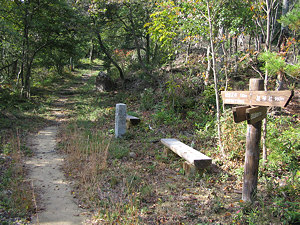 Introduction. I became interested in the Saigoku pilgrimage
(Saikoku Sanjusansho junrei) after reading the Tale of Genji in
2000. I was fascinated at the importance of pilgrimage to Heian-era
aristocrats, and to women like Murasaki Shikibu in particular. So the
pilgrimage for me started out as a kind of cultural investigation, to
find out why it had been and still was so important in the lives of the
Japanese.
Introduction. I became interested in the Saigoku pilgrimage
(Saikoku Sanjusansho junrei) after reading the Tale of Genji in
2000. I was fascinated at the importance of pilgrimage to Heian-era
aristocrats, and to women like Murasaki Shikibu in particular. So the
pilgrimage for me started out as a kind of cultural investigation, to
find out why it had been and still was so important in the lives of the
Japanese.
I picked up
The Traveler's Guide to Japanese Pilgrimages - the only
English-language guide to the Saigoku pilgrimage - and Gateway to
Japan, which is probably the best guide to the culture of ancient
Japan. I did the pilgrimage as a series of day-trips from Kyoto and I
didn't visit the temples in sequential order. In retrospect, it was a
mistake not to learn more about Japanese Buddhism and about Kannon in
particular, but more about that later.
Ishiyamadera (#13) April 2001. This
was my fifth short visit to Japan and the first in which I visited
places mentioned in the Tale of Genji. Not only does Ishiyamadera
feature in the Tale, but according to legend the author began writing
her famous novel there.
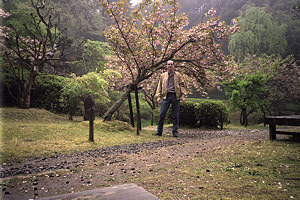 I took a train from Kyoto's Keihan-Sanjo station, changing at Hama-Otsu for Ishiyamadera
station at the end of the Sakamoto local line. From the station I walked for 10 minutes in
the rain beside Lake Biwa until I reached the temple gate. After buying my ticket and
getting a leaflet in Japanese, an old lady just inside the barrier handed me an English
leaflet. Climbing the steps to the right, the rain stopped and I came out on the temple's
gravel courtyard, stone lanterns and a pagoda on the opposite side and water dripping from
the lush, green foliage. The scene had a kind of magical quality about it.
I took a train from Kyoto's Keihan-Sanjo station, changing at Hama-Otsu for Ishiyamadera
station at the end of the Sakamoto local line. From the station I walked for 10 minutes in
the rain beside Lake Biwa until I reached the temple gate. After buying my ticket and
getting a leaflet in Japanese, an old lady just inside the barrier handed me an English
leaflet. Climbing the steps to the right, the rain stopped and I came out on the temple's
gravel courtyard, stone lanterns and a pagoda on the opposite side and water dripping from
the lush, green foliage. The scene had a kind of magical quality about it.
Inside the hondo the image on display is a Nyorin Kannon and this is one of the few
temples that have benches for visitors to sit and contemplate it. But the original clay
image is displayed only once every 33 years. The hondo also has a long
balcony overlooking a small valley. Beside the balcony is an image of
Binzuru that visitors rub in the hope of curing ailments. Binzuru (Skt.
Pindola) was one of the Buddha's disciples. His reputation for occult
powers such as flying is perhaps why his image is usually seen outside
or at the entrance of temple buildings.
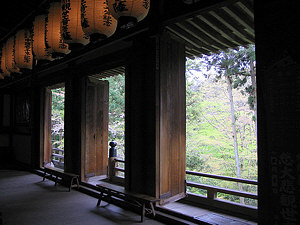 Leaving the hondo, visitors turn left past the Genji Room - which has a
life-size image of Murasaki Shikibu - and climb up past the
belfry and tahoto to the moon-viewing pavilion. You can't go in the
pavilion but the cherry-blossom below is beautiful in April and the
temple is open late on the eve of the Harvest moon. A path leads up the
hill to the treasure house and a little way past it a small trail leads
up to a pavilion and a statue of Murasaki.
Leaving the hondo, visitors turn left past the Genji Room - which has a
life-size image of Murasaki Shikibu - and climb up past the
belfry and tahoto to the moon-viewing pavilion. You can't go in the
pavilion but the cherry-blossom below is beautiful in April and the
temple is open late on the eve of the Harvest moon. A path leads up the
hill to the treasure house and a little way past it a small trail leads
up to a pavilion and a statue of Murasaki.
The path winds back down to the small valley beneath the hondo and its
charming garden centred around a carp pool and waterfall. There is a
pavilion for viewing the pond and irises in May. In recent years the
temple has cut down trees to plant daffodils and created rock terraces
up on the hill, while building iris beds in the pond. The result is not
as natural as it once was.
I returned to Ishiyamadera in September 2001, bought a nokyocho
(pilgrim's book) from the temple office and so officially started the
Saigoku pilgrimage. I watched other visitors and the procedure seemed
to be to throw some coins in the donation box, ring the bell twice and
pray. Lighting incense or candles requires another donation. I later
discovered that the bell should be rung three times, probably as a
reminder of the Buddha, the Dharma, and the Sangha, but perhaps some
Japanese are used to the Shinto practice of clapping twice ("to wake
the gods") before praying. There are specific chants for each
temple and a specific mantra for Kannon, but I didn't know what
they were and didn't see the point in using anything I didn't
understand. In the end I settled for a short prayer for the
health and happiness of loved ones and used this for over half
of the pilgrimage.
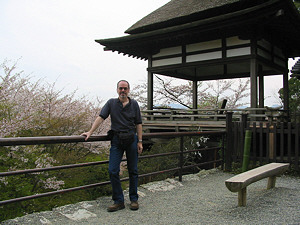 I have been to Ishiyamadera at least five times and always enjoyed it.
On my last visit there were some ancient images on display in the area
of the hondo behind the barrier, and visitors could pay 300 yen to go
inside and look. There was an image of Fudo Myo-o and one of Kichijoten. A couple of monks appeared and
talked to me about the temple and the images. When I asked about the
principal kannon image that is only shown every 33 years they pointed
to a dusty old poster photograph of it and informed me that it was also
displayed in the event of a royal birth. I was a bit surprised to find
serious meditation monks in a temple on the tourist route. One had been
in robes for 27 years and the other for 7 years.
I have been to Ishiyamadera at least five times and always enjoyed it.
On my last visit there were some ancient images on display in the area
of the hondo behind the barrier, and visitors could pay 300 yen to go
inside and look. There was an image of Fudo Myo-o and one of Kichijoten. A couple of monks appeared and
talked to me about the temple and the images. When I asked about the
principal kannon image that is only shown every 33 years they pointed
to a dusty old poster photograph of it and informed me that it was also
displayed in the event of a royal birth. I was a bit surprised to find
serious meditation monks in a temple on the tourist route. One had been
in robes for 27 years and the other for 7 years.
Hasedera (#8) April 2001. Hasedera was
second on my list because it also plays a part in The Tale of
Genji. Taking a limited express on the private Kintetsu line, I
switched to a local line at Yagi and got off at Hasedera station three
stops later. Following a path leading down to the river, I crossed the
bridge, turned right and walked along a street running parallel to the
river. The street used to be lined with pilgrim's lodgings, but now it
is mostly souvenir shops and several temples, one of which is a Bangai
(unnumbered pilgrimage temple).
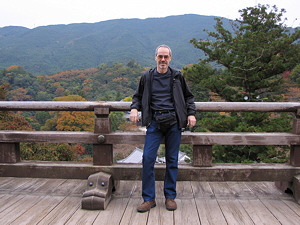 The path eventually turned up and to the left before reaching Hasedera.
Then there were endless low steps up to the hondo. As I entered, I got
my first glimpse of the awesome eight-metre statue of Kannon towering
above on the right. A woman in front of me said, "Ah.. Sugoi!" To the
left was a raised platform opening onto a larger veranda with a
spectacular view of the valley below. At the other side of the hondo I
came across the usual statue of Binzuru and a path leading down to other
temple buildings, the pagoda and beds of peonies.
The path eventually turned up and to the left before reaching Hasedera.
Then there were endless low steps up to the hondo. As I entered, I got
my first glimpse of the awesome eight-metre statue of Kannon towering
above on the right. A woman in front of me said, "Ah.. Sugoi!" To the
left was a raised platform opening onto a larger veranda with a
spectacular view of the valley below. At the other side of the hondo I
came across the usual statue of Binzuru and a path leading down to other
temple buildings, the pagoda and beds of peonies.
In spring and autumn the temple can be crowded and there isn't much
room to stand and admire the main image. When I returned on a
subsequent visit to have my nokyocho stamped, a young man was
prostrated in front of the image and really wailing in supplication to
Kannon - an unusual sight on this pilgrimage. On another occasion, I
had come to photograph the Hase River, intending to skip the temple and
catch a taxi to nearby Muroji. But there were few people around on that
day and only one parked taxi with no driver to be seen. As it was
already late afternoon I gave up on my original plan and climbed up to
Hasedera. This time I was alone and able to spend half an hour in the
darkened hondo contemplating the ancient carving of Kannon lit by a
lantern and flickering candles.
When statues are life-size or larger they seem to have a powerful
effect on the human mind that goes beyond religious faith or devotion.
From a Buddhist perspective, this effect can be used as an inspiration
for practice. The bodhisattva ideal of enduring countless lifetimes of
suffering to help others, the piety of those who carved the image and
the devotion of the pilgrims who came to worship it down through the
centuries are all a powerful reminder of the human condition.
Although not part of the pilgrimage, Muroji
temple is not far from Hasedera and is not to be missed. It's a couple
of stops past Hasedera on the same rail line and then a local bus trip
of about 15 minutes. Muroji is a mountain temple with some fine
statuary.
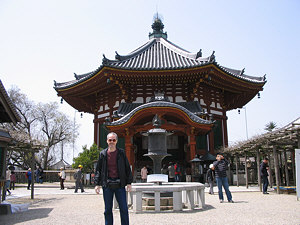 Nanendo (#9) October 2001. Dating
from 813, Nanendo Hall was originally part of Kofukuji Temple, one of
the Seven Great Temples of Nara, which are briefly mentioned in the
Genji. Nanendo can be reached from Kyoto by taking a train on
the Kintetsu Line to the Nara terminus and walking for 5 minutes. The
hall is octagonal in shape and has a wisteria arbour in front, but
there's not much to see there. The main image is a Fukukensaku Kannon,
but the building is only open one day a year on October 17. The
historic Sarusawa Pond is down a flight of steps and is a pleasant
place to sit for a while. I combined the trip to Nanendo with a visit
to the nearby treasure house of Kofukuji
and to Todaiji, home of the Great
Buddha.
Nanendo (#9) October 2001. Dating
from 813, Nanendo Hall was originally part of Kofukuji Temple, one of
the Seven Great Temples of Nara, which are briefly mentioned in the
Genji. Nanendo can be reached from Kyoto by taking a train on
the Kintetsu Line to the Nara terminus and walking for 5 minutes. The
hall is octagonal in shape and has a wisteria arbour in front, but
there's not much to see there. The main image is a Fukukensaku Kannon,
but the building is only open one day a year on October 17. The
historic Sarusawa Pond is down a flight of steps and is a pleasant
place to sit for a while. I combined the trip to Nanendo with a visit
to the nearby treasure house of Kofukuji
and to Todaiji, home of the Great
Buddha.
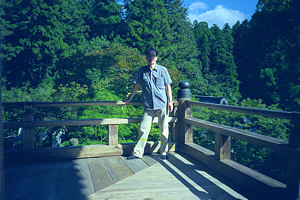 Engyoji (#27) October 2001. On my way
to Himeji Castle by bullet train I happened to notice that Engyoji
Temple was nearby and easy to reach. Luckily, there was a Tourist
Information Office at the station and within minutes I was on a bus
headed for the foot of Mount Shosha, followed by a cable car to the
top. There is a pleasant path through the forest to this large monastic
complex, with several bodhisattva statues along the way. The temple
hondo has a long veranda with a fine view of the forest, while further
up the hill is the lecture hall and courtyard that were featured in
The Last Samurai.
Engyoji (#27) October 2001. On my way
to Himeji Castle by bullet train I happened to notice that Engyoji
Temple was nearby and easy to reach. Luckily, there was a Tourist
Information Office at the station and within minutes I was on a bus
headed for the foot of Mount Shosha, followed by a cable car to the
top. There is a pleasant path through the forest to this large monastic
complex, with several bodhisattva statues along the way. The temple
hondo has a long veranda with a fine view of the forest, while further
up the hill is the lecture hall and courtyard that were featured in
The Last Samurai.
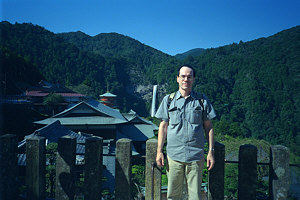 Seigantoji (#1) October 2001.
Originally one of the three temples of the syncretic Kumano faith,
Seigantoji later became the first temple of the Saigoku pilgrimage.
Although Kumano is mentioned briefly in the Genji, I was
attracted to it mainly because of the famous Nachi Falls. Situated near
the tip of the Kii Peninsula, Seigantoji is a long way from anywhere. I
took a train on the JR Kisei Line from Osaka to Kii-Katsuura, which
took several hours, and then a bus to the temple (40 minutes). I missed
the bus stop by the falls and got off at the terminus up the hill.
Nachi Taisha grand shrine is at the top of some steps and the temple is
behind it. Both were busy when I was there. At Seigantoji, the monks
were friendly and the temple sold everything a pilgrim could want. A
woman lent me her pilgrim's staff as I posed for a photograph in front
of the shrine. The falls appeared to be miles away and, worried I might
miss the bus back, I didn't walk down for a closer look. On the return
trip, I managed to catch a limited express train all the way to
Kyoto.
Seigantoji (#1) October 2001.
Originally one of the three temples of the syncretic Kumano faith,
Seigantoji later became the first temple of the Saigoku pilgrimage.
Although Kumano is mentioned briefly in the Genji, I was
attracted to it mainly because of the famous Nachi Falls. Situated near
the tip of the Kii Peninsula, Seigantoji is a long way from anywhere. I
took a train on the JR Kisei Line from Osaka to Kii-Katsuura, which
took several hours, and then a bus to the temple (40 minutes). I missed
the bus stop by the falls and got off at the terminus up the hill.
Nachi Taisha grand shrine is at the top of some steps and the temple is
behind it. Both were busy when I was there. At Seigantoji, the monks
were friendly and the temple sold everything a pilgrim could want. A
woman lent me her pilgrim's staff as I posed for a photograph in front
of the shrine. The falls appeared to be miles away and, worried I might
miss the bus back, I didn't walk down for a closer look. On the return
trip, I managed to catch a limited express train all the way to
Kyoto.
Mimurotoji (#10) October 2001.
During the Heian period, Uji was a wild and remote area south of Kyoto
where aristocrats built their country villas. By the mid-11th century,
as the "degenerate age" of Buddhism (mappo) approached, some of
the villas were converted to Amida temples. The last 10 chapters of
The Tale of Genji are set in Uji.
To reach Mimurotoji, I took a train on the Keihan Line from Kyoto and
walked for 15 minutes up the hill on the east side of the river. It's a
beautiful Chinese-style temple with pots of lotus plants in front of
the hondo and a garden full of hydrangeas lower down the hill. Beside
the belfry is a carved stone memorial to Hashihime, the deity of Uji
Bridge, which is associated with the Genji. The monks seemed to
be particularly friendly at this temple.
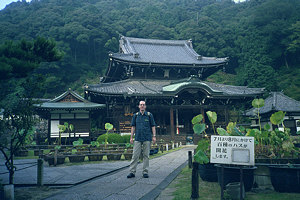 On one of the small paths leading down to the river I passed the Tale
of Genji Museum which was just closing.
On one of the small paths leading down to the river I passed the Tale
of Genji Museum which was just closing.
On a subsequent visit to Uji in the cherry-blossom season I spent a
whole day exploring the temples on the east side of the river, Ujigami
Shrine, and Byodo-in, one of the few
remaining Heian-era Amida halls. There is another Amida hall at Hokaiji, just north of Uji and a third at Joruriji, near Nara.
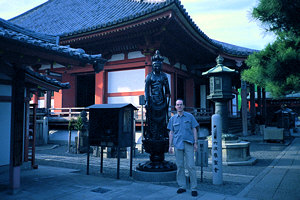 Rokuharamitsuji (#17) October
2001. By the middle of this trip I was getting enthusiastic about
the pilgrimage and decided to visit four more temples in Kyoto.
Rokuharamitsuji seemed like a good place to start because it was the
former residence of Taira Kiyomori, who presided over the end of the
Heian era and was a major character in The Tale of the Heike.
The temple is walkable from Keihan-Gojo station but I took a taxi since
it was late in the afternoon. A rather fierce-looking statue of Kannon
stands in the courtyard and a monk offered to take my photo standing
beside it. The temple's main attraction is the statuary inside,
particularly an image of Kiyomori and a unique carving of Kuya, one of
the early Amidist street-preachers, with six images of Amida coming out
of his mouth. The images are said to represent the six paramitas
(perfections) of Mahayana Buddhism.
Rokuharamitsuji (#17) October
2001. By the middle of this trip I was getting enthusiastic about
the pilgrimage and decided to visit four more temples in Kyoto.
Rokuharamitsuji seemed like a good place to start because it was the
former residence of Taira Kiyomori, who presided over the end of the
Heian era and was a major character in The Tale of the Heike.
The temple is walkable from Keihan-Gojo station but I took a taxi since
it was late in the afternoon. A rather fierce-looking statue of Kannon
stands in the courtyard and a monk offered to take my photo standing
beside it. The temple's main attraction is the statuary inside,
particularly an image of Kiyomori and a unique carving of Kuya, one of
the early Amidist street-preachers, with six images of Amida coming out
of his mouth. The images are said to represent the six paramitas
(perfections) of Mahayana Buddhism.
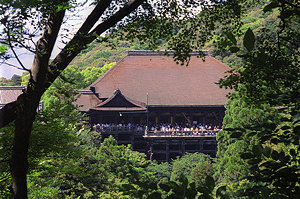 Kiyomizudera (#16) October 2001.
Like Ishiyamadera and Hasedera temples, Kiyomizudera was a popular
Heian pilgrimage and features in a dramatic episode in The Tale of
Genji when the distraught hero returns from the secret funeral of
his lover Yugao. I walked there after visiting other temples in
Higashiyama. The path up to the temple is lined with old houses and
gift shops, and it is common to see maiko (apprentice geisha) posing
for photos there and in front of the temple gate.
Kiyomizudera (#16) October 2001.
Like Ishiyamadera and Hasedera temples, Kiyomizudera was a popular
Heian pilgrimage and features in a dramatic episode in The Tale of
Genji when the distraught hero returns from the secret funeral of
his lover Yugao. I walked there after visiting other temples in
Higashiyama. The path up to the temple is lined with old houses and
gift shops, and it is common to see maiko (apprentice geisha) posing
for photos there and in front of the temple gate.
The temple is always crowded with tourists and pilgrims. When I
arrived, there was a long queue to pay respects to the image of Kannon
by kneeling and striking a large metal bowl rather than the usual bell
seen at most temples. The main attraction is the huge platform jutting
out over the hillside and its magnificent view over Kyoto. The temple
grounds are extensive, so I walked up to the Shinto shrine selling
lucky charms, round the side of the hill and back down to the small
waterfall. The temple is famous for both cherry blossom and Autumn
leaves - sometimes illuminated at night - but I wish there were less
visitors.
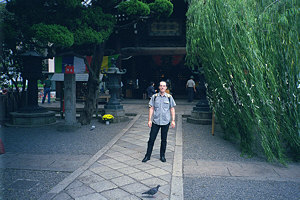 Rokkakudo (#18) October 2001.
Located a short distance southeast of Sanjo-Karasuma subway station,
Rokkakudo is easy to reach but there isn't much to look at. The temple,
which predates Kyoto by some 200 years, takes its name from the
hexagonal shape of the main hall and is the birthplace of ikebana, the
art of flower-appreciation. According to legend, when
geomancers were surveying the land for the new capital of Kyoto
they found Rokkakudo to be occupying dead centre and ordered it
to be destroyed. But a loud ringing - like a temple bell - was
heard coming from a rock in the temple grounds soon after so it was
decided to leave the temple alone. The stone is still at the
temple, marking the centre of Kyoto.
Rokkakudo (#18) October 2001.
Located a short distance southeast of Sanjo-Karasuma subway station,
Rokkakudo is easy to reach but there isn't much to look at. The temple,
which predates Kyoto by some 200 years, takes its name from the
hexagonal shape of the main hall and is the birthplace of ikebana, the
art of flower-appreciation. According to legend, when
geomancers were surveying the land for the new capital of Kyoto
they found Rokkakudo to be occupying dead centre and ordered it
to be destroyed. But a loud ringing - like a temple bell - was
heard coming from a rock in the temple grounds soon after so it was
decided to leave the temple alone. The stone is still at the
temple, marking the centre of Kyoto.
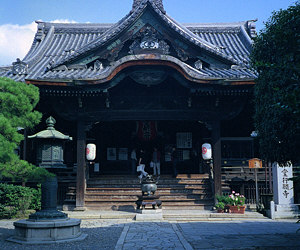 Kodo (#19) October 2001. A short train
journey and walk took me to Kodo Temple on Teramachi, a long, partly
covered street running parallel to Kawaramachi. The street has a number
of temples and is a good place to buy Buddha images, rosaries, and
other Buddhist items. This temple is the only temple on the pilgrimage
that is run by nuns, but the calligraphy entered in my pilgrim's book
at Kodo was unusually bold and dark. Rozanji
Temple, formerly the home of Murasaki Shikubu, is also on Teramachi,
not far away. There are some artifacts linked to Murasaki's family in a
small display area and bellflowers bloom in the garden in Autumn. It is
likely that Murasaki wrote parts of The Tale of Genji
here.
Kodo (#19) October 2001. A short train
journey and walk took me to Kodo Temple on Teramachi, a long, partly
covered street running parallel to Kawaramachi. The street has a number
of temples and is a good place to buy Buddha images, rosaries, and
other Buddhist items. This temple is the only temple on the pilgrimage
that is run by nuns, but the calligraphy entered in my pilgrim's book
at Kodo was unusually bold and dark. Rozanji
Temple, formerly the home of Murasaki Shikubu, is also on Teramachi,
not far away. There are some artifacts linked to Murasaki's family in a
small display area and bellflowers bloom in the garden in Autumn. It is
likely that Murasaki wrote parts of The Tale of Genji
here.
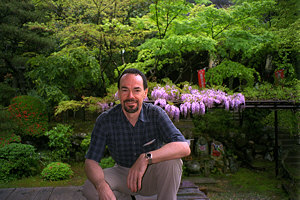 Imakumano Kannonji (#15) April
2002. The day I went to Kannonji it was raining. It was raining as
I got off the train at Tofukuji Station, raining as I walked up the
hill and pouring as I reached the temple 20 minutes later. To my
surprise, wisteria was in bloom outside the temple - the first I'd ever
seen - but the heavy rain made it difficult to take photos. As I
attempted to get a tripod shot of myself on the temple veranda, a woman
with a teenaged daughter offered to help.
Imakumano Kannonji (#15) April
2002. The day I went to Kannonji it was raining. It was raining as
I got off the train at Tofukuji Station, raining as I walked up the
hill and pouring as I reached the temple 20 minutes later. To my
surprise, wisteria was in bloom outside the temple - the first I'd ever
seen - but the heavy rain made it difficult to take photos. As I
attempted to get a tripod shot of myself on the temple veranda, a woman
with a teenaged daughter offered to help.
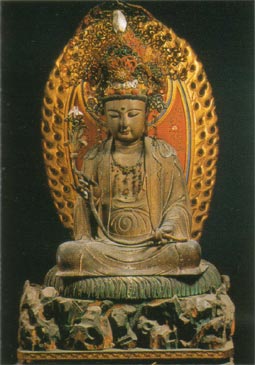 With the usual sign language I indicated I was looking for the Yokihi Kannon, which I knew was somewhere
in the area. She hadn't heard of it, but she asked a monk and offered
to show me the way. We trudged up the hill in pouring rain, paid
admission to the Sennyuji Temple complex
and found a small Kannon-do just inside the gate. The history of this
Kannon image goes all the way back to 8th Century China and the last
emperor of the Tang Dynasty. After falling for the beautiful concubine,
Yang Kwei-fei, the emperor neglected affairs of state and, after a
rebellion, his soldiers blamed Yang and her relatives. As they
retreated from the rebels, Yang was either strangled by a eunuch or
forced to commit suicide. The Tang Dynasty never recovered and the
emperor's remorse became the subject of a famous poem by Po Chu-i and
of numerous references in ancient Japanese literature. It is said that
the emperor missed his beloved concubine so much that he had her
sculpture made in the image of Avalokitesvara (Kannon), which was
brought to Sennyuji Temple in Kyoto by the priest Tankai in
1255.
With the usual sign language I indicated I was looking for the Yokihi Kannon, which I knew was somewhere
in the area. She hadn't heard of it, but she asked a monk and offered
to show me the way. We trudged up the hill in pouring rain, paid
admission to the Sennyuji Temple complex
and found a small Kannon-do just inside the gate. The history of this
Kannon image goes all the way back to 8th Century China and the last
emperor of the Tang Dynasty. After falling for the beautiful concubine,
Yang Kwei-fei, the emperor neglected affairs of state and, after a
rebellion, his soldiers blamed Yang and her relatives. As they
retreated from the rebels, Yang was either strangled by a eunuch or
forced to commit suicide. The Tang Dynasty never recovered and the
emperor's remorse became the subject of a famous poem by Po Chu-i and
of numerous references in ancient Japanese literature. It is said that
the emperor missed his beloved concubine so much that he had her
sculpture made in the image of Avalokitesvara (Kannon), which was
brought to Sennyuji Temple in Kyoto by the priest Tankai in
1255.
Most temples sell lucky charms known as omamori, which are
pieces of wood inside a cloth bag. This temple was the first I'd seen
where visitors could choose their own charm and put it in the bag.
Since I couldn't understand what the charms represented, my companions
chose one for me. We then walked down a hill to look at the statuary in
Sennyuji's main hall and an unusual painting of Kannon, whose eyes seem
to look directly at you, no matter where you stand. It was still
raining when we left the temple.
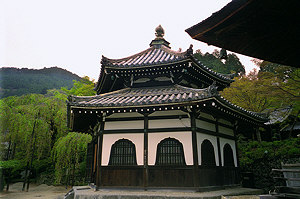 Yoshiminedera (#20) April 2002.
The following day I took a JR Tokaido line train to Mukomachi station
in the Oharano area southwest of Kyoto and, pressed for time, took a
taxi up to Yoshiminedera temple instead of the bus. The temple is
spread out over the side of a mountain with long walks between some of
the buildings. Although there were no images on view at the hondo, I
did pray there. There are mineral baths in the temple grounds, which
are said to be effective for those suffering from neuralgia and
lumbago, as apparently is praying at the hondo. About a year after
this, my neuralgia slowly faded away.
Yoshiminedera (#20) April 2002.
The following day I took a JR Tokaido line train to Mukomachi station
in the Oharano area southwest of Kyoto and, pressed for time, took a
taxi up to Yoshiminedera temple instead of the bus. The temple is
spread out over the side of a mountain with long walks between some of
the buildings. Although there were no images on view at the hondo, I
did pray there. There are mineral baths in the temple grounds, which
are said to be effective for those suffering from neuralgia and
lumbago, as apparently is praying at the hondo. About a year after
this, my neuralgia slowly faded away.
On the second level I found the sutra hall and a statue of Fu Daishi
(497-569), the highly respected Chinese lay Buddhist who invented
octagonal revolving sutra shelves. On this level is a 600-year-old pine
tree with a single branch extending horizontally for 150 feet. There
were several paths leading from here up the mountain but I couldn't
figure out the Japanese-language map in the temple brochure so I headed
back down to the main gate. From there I walked along the road some
distance until I came to Jurinji Temple,
where cherry blossom was in full bloom.
The woman at the ticket office spoke some English and asked what was my
interest in Jurinji. I replied that I was a fan of The Tale of
Genji, which seemed to satisfy her. The Genji contains many
references to Tales of Ise, which was written by the legendary
lover Ariwara no Narihira, who spent some time at Jurinji (the temple
is also known at Narihiradera). Behind the temple are the remains of a
kiln that Narihira used to make salt from seawater. Beside the hondo is
a room with some fine statuary, but when I pulled out my camera the
ticket-office lady came rushing in and reminded me that taking
photographs was not allowed. I looked around and saw the close-circuit
TV camera up above. There was a bus stop near the temple and a bus came
by 20 minutes later.
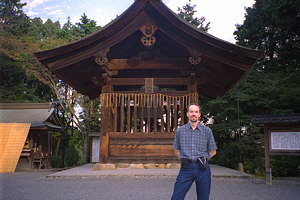 Miidera (#14) October 2002. Officially
known as Onjoji Temple, Miidera is on the same local rail line as
Ishiyamadera and just one stop past Hama Otsu in the direction of
Sakamoto. It's a five-minute walk from Miidera station. The temple has
a great view of Lake Biwa and extensive
grounds but is architecturally uninteresting. One attraction is the
bell that folk-hero Benkei is said to have dragged up Mount Hiei and
down again during a battle. Nearby is another bell, which has the most
beautiful sound in Japan. It was here that I set up my tripod for a
snapshot.
Miidera (#14) October 2002. Officially
known as Onjoji Temple, Miidera is on the same local rail line as
Ishiyamadera and just one stop past Hama Otsu in the direction of
Sakamoto. It's a five-minute walk from Miidera station. The temple has
a great view of Lake Biwa and extensive
grounds but is architecturally uninteresting. One attraction is the
bell that folk-hero Benkei is said to have dragged up Mount Hiei and
down again during a battle. Nearby is another bell, which has the most
beautiful sound in Japan. It was here that I set up my tripod for a
snapshot.
Murasaki Shikibu's brother was an abbot of Miidera Temple, which is
probably why her father took vows there. In its heyday the temple was a
rival to Enryakuji on sacred Mount Hiei
and the monks sometimes fought with each other. They were also not
above marching on the capital to extract demands from the emperor.
Mount Hiei is a pilgrimage in its own right and well worth a day's
visit. There is a cable car from Sakamoto, further up the line from
Miidera station.
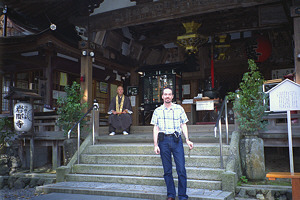 Iwamadera (#12) October 2002.
The bus for Iwamadera leaves once in a blue moon and doesn't go all the
way to the temple. The walk would be well over an hour, uphill, with no
signs in English. This is why I had put off going there for so long. In
the end I made a spur-of-the-moment decision to go there while visiting
nearby Ishiyamadera. There are always plenty of taxis waiting outside
Ishiyamadera, so I took one of those and had the driver wait at the
temple. It cost around 5,000 yen for the round-trip.
Iwamadera (#12) October 2002.
The bus for Iwamadera leaves once in a blue moon and doesn't go all the
way to the temple. The walk would be well over an hour, uphill, with no
signs in English. This is why I had put off going there for so long. In
the end I made a spur-of-the-moment decision to go there while visiting
nearby Ishiyamadera. There are always plenty of taxis waiting outside
Ishiyamadera, so I took one of those and had the driver wait at the
temple. It cost around 5,000 yen for the round-trip.
When I arrived a monk - perhaps the abbot - was sitting at the entrance
so I took a couple of photographs. A little later he indicated that
there was a bamboo forest behind the temple, so I went to take a look.
I spent so much time admiring the view that I completely forgot to look
for the pond that inspired Basho's famous haiku about the sound of a
frog jumping into the water. But it turned out later that I did at
least get a photo of it.
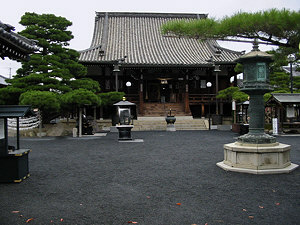 Sojiji (#22) November 2003.
I had saved Sojiji and Anaoji temples for a rainy day and the rain fell
constantly during the first four days of this November trip to Kyoto. I
took a train on the Hankyu Kyoto line for Sojiji station and walked 400
metres to the temple. There is an ugly, modern car park outside the
main gate and the temple courtyard is covered with dark gravel. All in
all, pretty uninspiring so I didn't stay for long.
Sojiji (#22) November 2003.
I had saved Sojiji and Anaoji temples for a rainy day and the rain fell
constantly during the first four days of this November trip to Kyoto. I
took a train on the Hankyu Kyoto line for Sojiji station and walked 400
metres to the temple. There is an ugly, modern car park outside the
main gate and the temple courtyard is covered with dark gravel. All in
all, pretty uninspiring so I didn't stay for long.
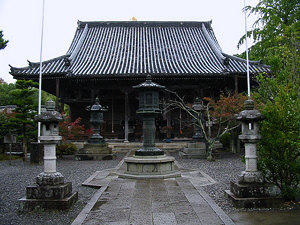 Anaoji (#21) November 2003. Anaoji is
reached by taking a JR Sanin Line train to Kameoka station. The scenery
on this route is pretty wild considering it isn't that far from Kyoto.
Because of the rain, I took a taxi from the station and had the driver
wait. There isn't much at Anaoji other than a small tahoto and a few
small maple trees. A carving of a reclining Buddha is sometimes
displayed but it wasn't on view when I was there.
Anaoji (#21) November 2003. Anaoji is
reached by taking a JR Sanin Line train to Kameoka station. The scenery
on this route is pretty wild considering it isn't that far from Kyoto.
Because of the rain, I took a taxi from the station and had the driver
wait. There isn't much at Anaoji other than a small tahoto and a few
small maple trees. A carving of a reclining Buddha is sometimes
displayed but it wasn't on view when I was there.
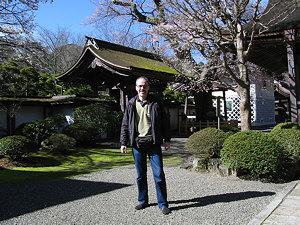 Fujiidera (#5) April 2004.
A few temples on the Saigoku Pilgrimage have lodgings for pilgrims, but
a foreigner would have difficulty making a booking. To get a feel of
how the pilgrimage used to be, I headed for Mount Koya, the centre of
Shingon Buddhism, where nine temples offer lodgings for non-Japanese.
Taking a Keihan line train to Osaka's Yodobashi Station, I switched to
the Mido-suji subway line and got off at Namba. From there I walked
through to Nankai Namba station and caught the limited express to
Koyasan. The last stop is Gokurakubashi, which means "Bridge to
Paradise," and then it's a cable car to the top of the
mountain and a bus into the village.
Fujiidera (#5) April 2004.
A few temples on the Saigoku Pilgrimage have lodgings for pilgrims, but
a foreigner would have difficulty making a booking. To get a feel of
how the pilgrimage used to be, I headed for Mount Koya, the centre of
Shingon Buddhism, where nine temples offer lodgings for non-Japanese.
Taking a Keihan line train to Osaka's Yodobashi Station, I switched to
the Mido-suji subway line and got off at Namba. From there I walked
through to Nankai Namba station and caught the limited express to
Koyasan. The last stop is Gokurakubashi, which means "Bridge to
Paradise," and then it's a cable car to the top of the
mountain and a bus into the village.
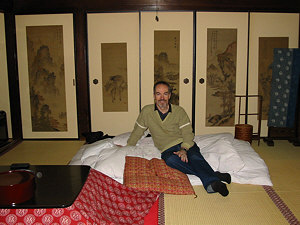 By the time I arrived at Shojoshinin
Temple, my lodgings for the next two nights, it was getting dark. The
temple is situated on the edge of the huge forest-cemetary that
surrounds the Okunoin where Kobo Daishi, the founder of Shingon
Buddhism, is entombed, so I decided to take a walk. The path to the Okuno-in is lit up but it was so misty that I
turned back because I could hardly see where I was going. At the temple
I discovered I had a room on the ground floor beside a pond and
wisteria arbour. There were painted panels separating the rooms but no
locks of any kind on the sliding wooden doors. I noticed that one of
the paintings was of the Tang Dynasty poet, Li Po, gazing into a
waterfall with a servant hanging on to him (legend has it that he
drowned while drunk and trying to embrace the reflection of the moon in
a river). I had the curious feeling that I belonged in that
room. After relaxing in a hot wooden bath for a while, I got under the
futon (the temperature drops considerably at night) and spent a couple
of hours listening to Mozart on my Walkman.
By the time I arrived at Shojoshinin
Temple, my lodgings for the next two nights, it was getting dark. The
temple is situated on the edge of the huge forest-cemetary that
surrounds the Okunoin where Kobo Daishi, the founder of Shingon
Buddhism, is entombed, so I decided to take a walk. The path to the Okuno-in is lit up but it was so misty that I
turned back because I could hardly see where I was going. At the temple
I discovered I had a room on the ground floor beside a pond and
wisteria arbour. There were painted panels separating the rooms but no
locks of any kind on the sliding wooden doors. I noticed that one of
the paintings was of the Tang Dynasty poet, Li Po, gazing into a
waterfall with a servant hanging on to him (legend has it that he
drowned while drunk and trying to embrace the reflection of the moon in
a river). I had the curious feeling that I belonged in that
room. After relaxing in a hot wooden bath for a while, I got under the
futon (the temperature drops considerably at night) and spent a couple
of hours listening to Mozart on my Walkman.
At 6am I attended a service in the temple hall, which was mostly
chanting prayers for ancestors, and then had breakfast in my room. At
Shojoshinin, no food or drink is allowed in from outside but the monks
serve delicious vegetarian food with green tea for breakfast and
dinner. The main attractions of Mount Koya are the Garan, Kongobuji, the treasure house and
the Okunoin, but there are plenty of other temples to visit.
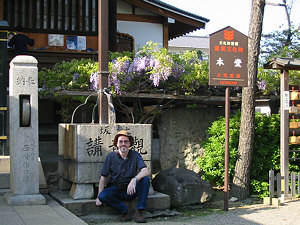 The following day I headed back to Osaka. From Osaka's Tennoji station
I took a local on the Kintetsu Osaka line to Fujiidera station in the
suburbs. Fujiidera temple is a few minutes walk through a shopping
arcade. The first thing I noticed was wisteria blooming in great
profusion around the temple - both lavender and white varieties. In
front of the hondo there was a stone prayer wheel and one of the ugly
Hitatchi signs that are common in temple courtyards. The
principal image at Fujiidera is a remarkable thousand-armed Kannon -
one of the few that really has a thousand arms - but it is
only displayed on the 18th of the month.
The following day I headed back to Osaka. From Osaka's Tennoji station
I took a local on the Kintetsu Osaka line to Fujiidera station in the
suburbs. Fujiidera temple is a few minutes walk through a shopping
arcade. The first thing I noticed was wisteria blooming in great
profusion around the temple - both lavender and white varieties. In
front of the hondo there was a stone prayer wheel and one of the ugly
Hitatchi signs that are common in temple courtyards. The
principal image at Fujiidera is a remarkable thousand-armed Kannon -
one of the few that really has a thousand arms - but it is
only displayed on the 18th of the month.
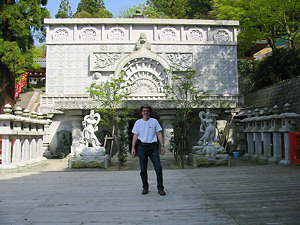 Tsubosakadera (#6) April 2004.
Tsubosakadera was a relatively easy train ride on the Kintetsu
Kashihara line south of Nara, Yamato Yagi and Kashihara Jingumae. A
short bus ride took me to the temple gate. The first building I entered
was the Jogando, made from white stone and reminiscent of an Indian
cave temple. There is nothing else like it on the pilgrimage. On the
next level is the hondo, containing a very Indian-style Senju Kannon.
Visitors are able to get very close to the image and a friendly monk
sits nearby explaining the history of the temple, which is famous for
its work with the blind and help for lepers in India.
Tsubosakadera (#6) April 2004.
Tsubosakadera was a relatively easy train ride on the Kintetsu
Kashihara line south of Nara, Yamato Yagi and Kashihara Jingumae. A
short bus ride took me to the temple gate. The first building I entered
was the Jogando, made from white stone and reminiscent of an Indian
cave temple. There is nothing else like it on the pilgrimage. On the
next level is the hondo, containing a very Indian-style Senju Kannon.
Visitors are able to get very close to the image and a friendly monk
sits nearby explaining the history of the temple, which is famous for
its work with the blind and help for lepers in India.
The temple has other attractions - a long wall of stone carvings
depicting Jataka Tales from the Buddha's former lives, a copy of a 1st
century stone carving from Amaravati, a 15th century pagoda and a
20-metre stone sculpture of Kannon. At a small shop in the temple
grounds a woman asked how I had got there and seemed impressed that I'd
used public transport, perhaps because I was limping a little from a
recently sprained ankle.
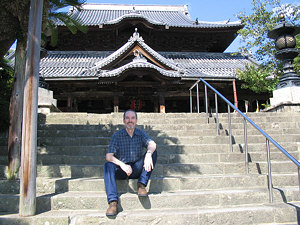 Kokawadera (#3) September 2004.
By September 2004 I had developed a serious interest in Buddhism and
was meditating regularly. This put a new perspective on the pilgrimage
for me. I was now more interested in the religious practices and
symbolism I encountered at the temples and in the differences between
the Theravada school of Southeast Asia and the Mahayana school that
Japanese Buddhists belong to. With regard to Kannon, I had found John
Blofeld's book on The Bodhisattva of Compassion particularly
helpful in understanding the difference between popular worship of this
so-called "goddess" and the higher-level meditation practice of
visualising the Bodhisattva Avalokitasvara.
Kokawadera (#3) September 2004.
By September 2004 I had developed a serious interest in Buddhism and
was meditating regularly. This put a new perspective on the pilgrimage
for me. I was now more interested in the religious practices and
symbolism I encountered at the temples and in the differences between
the Theravada school of Southeast Asia and the Mahayana school that
Japanese Buddhists belong to. With regard to Kannon, I had found John
Blofeld's book on The Bodhisattva of Compassion particularly
helpful in understanding the difference between popular worship of this
so-called "goddess" and the higher-level meditation practice of
visualising the Bodhisattva Avalokitasvara.
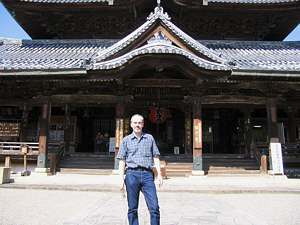 I went to Kokawadera after another visit to Mount Koya. Typhoon Niju
had passed through while I was staying in a temple on the mountain and
it was pretty wild for a night. But it was sunny again as I took the
train to Hashimoto and switched to the Wakayama Line for Kokawa
Station. The temple wasn't hard to find. Since it was so hot, I bought
some green tea ice cream and sat down to eat it at a small shop beside
the temple's wide gravel courtyard.
I went to Kokawadera after another visit to Mount Koya. Typhoon Niju
had passed through while I was staying in a temple on the mountain and
it was pretty wild for a night. But it was sunny again as I took the
train to Hashimoto and switched to the Wakayama Line for Kokawa
Station. The temple wasn't hard to find. Since it was so hot, I bought
some green tea ice cream and sat down to eat it at a small shop beside
the temple's wide gravel courtyard.
As I enjoyed my ice cream, an enormous centipede appeared from under a
cupboard and made a beeline for the backpack I had left on the floor. I
called and pointed it out to the old lady who ran the shop. Chuckling
at the idea of the centipede getting in my backpack, she selected a
large cleaver and proceeded to chop the unfortunate creature into
little pieces - a bit alarming considering this was in the grounds of a
Buddhist temple.
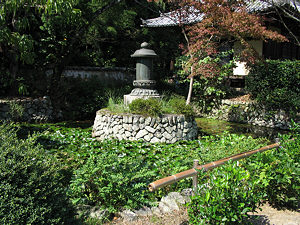 In the hondo, I recited the Three Refuges - a way of remaining mindful
of the importance of the Buddha, the Dharma (teachings) and the Sangha
(monastics) while cultivating the mind. In fact, the real purpose of
any Buddhist ritual is to improve one's mental state. If the symbolism
of the action isn't understood, it's pointless. Even lighting three
incense sticks or ringing a temple bell three times is a way to remind
oneself of the Three Refuges.
In the hondo, I recited the Three Refuges - a way of remaining mindful
of the importance of the Buddha, the Dharma (teachings) and the Sangha
(monastics) while cultivating the mind. In fact, the real purpose of
any Buddhist ritual is to improve one's mental state. If the symbolism
of the action isn't understood, it's pointless. Even lighting three
incense sticks or ringing a temple bell three times is a way to remind
oneself of the Three Refuges.
After spending some time in the hondo, I headed up to the level above
where I found a Chinese gate leading to a small garden and lily pond.
The pond contained the type of water hyacinth that clogs the canals and
rivers of Southeast Asia, but it didn't look so menacing flowering in
the small pool.
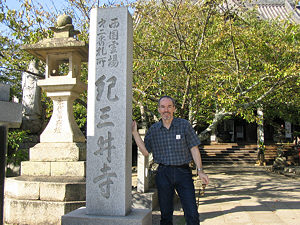 Kimiidera (#2) October 2004.
Continuing on the Wakayama line to Wakayama City, I changed
to a local on the JR Kisei line for the short journey to Kimiidera
station. The temple was half a kilometre south of the station. The area
seemed almost Mediterranean in the midday sun with white buildings,
palm trees and few people walking around. The temple had a fine view of
the sea, looking out towards Awaji Island, but
was otherwise unremarkable. It's main attraction is the
early-blossoming cherry trees in front of the hondo. An ugly,
Chinese-style building stood in the temple grounds although I couldn't
figure out what it was. As I walked back to the station, a couple of
tiny tots in school uniform approached me and said, "Harro." When I
replied, they said, "Ah! Sugoi!" From Kimiidera station it was
back to Wakayama station and then a train straight through to
Kyoto.
Kimiidera (#2) October 2004.
Continuing on the Wakayama line to Wakayama City, I changed
to a local on the JR Kisei line for the short journey to Kimiidera
station. The temple was half a kilometre south of the station. The area
seemed almost Mediterranean in the midday sun with white buildings,
palm trees and few people walking around. The temple had a fine view of
the sea, looking out towards Awaji Island, but
was otherwise unremarkable. It's main attraction is the
early-blossoming cherry trees in front of the hondo. An ugly,
Chinese-style building stood in the temple grounds although I couldn't
figure out what it was. As I walked back to the station, a couple of
tiny tots in school uniform approached me and said, "Harro." When I
replied, they said, "Ah! Sugoi!" From Kimiidera station it was
back to Wakayama station and then a train straight through to
Kyoto.
I had timed this particular trip so that I would be in Kyoto for the
Harvest Moon Festival and I wasn't disappointed. The moon-viewing at Daikakuji Temple and the bugaku performance at
Shimogamo Shrine are both
excellent.
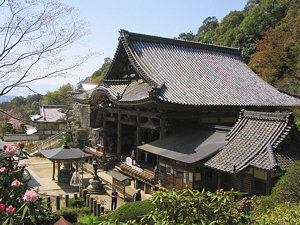 Okadera (#7) April 2005.
Okadera station doesn't have a bus service to the temple anymore. The
best way to get there is Kintetsu Kashihara line to Kashihara
Jingumae and then bus, or a little further down the line to Asuka
station and then rent a bicycle. My knees don't like cycling so I took
a taxi to the temple and had the driver wait. The hondo was large and
the principal image was an unusual 8th century Nyorin Kannon - Japan's
largest clay sculpture.
Okadera (#7) April 2005.
Okadera station doesn't have a bus service to the temple anymore. The
best way to get there is Kintetsu Kashihara line to Kashihara
Jingumae and then bus, or a little further down the line to Asuka
station and then rent a bicycle. My knees don't like cycling so I took
a taxi to the temple and had the driver wait. The hondo was large and
the principal image was an unusual 8th century Nyorin Kannon - Japan's
largest clay sculpture.
I continued on to nearby Asukadera,
Japan's first Buddhist temple, founded in the 6th century. What's left
of the temple is quite modest, but it still houses the country's oldest
existing Buddha image, a bronze sculpture of Shakyamuni cast by Tori Busshi in
609.
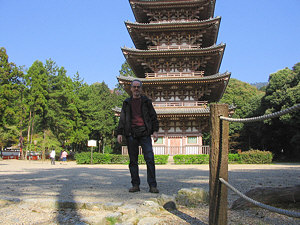 Kami Daigoji (#11) April 2005.
Although I had visited Daigoji before to see the procession celebrating
Hideyoshi's famous cherry-blossom party, I had never climbed up to Kami
Daigoji at the top of the mountain. This was mainly because the
guidebook described the path as so steep that that a rope was provided
to pull oneself up. It sounded daunting for someone with sore knees and
chronic ankle pain - but it had to be done sometime or other. So, one
sunny day when cherry trees were in blossom, I took the Tozai line
subway from Kyoto to Daigo station and then walked for 10-15
minutes to the temple gate.
Kami Daigoji (#11) April 2005.
Although I had visited Daigoji before to see the procession celebrating
Hideyoshi's famous cherry-blossom party, I had never climbed up to Kami
Daigoji at the top of the mountain. This was mainly because the
guidebook described the path as so steep that that a rope was provided
to pull oneself up. It sounded daunting for someone with sore knees and
chronic ankle pain - but it had to be done sometime or other. So, one
sunny day when cherry trees were in blossom, I took the Tozai line
subway from Kyoto to Daigo station and then walked for 10-15
minutes to the temple gate.
There were a lot of people entering the main gate as I arrived.
Daigoji features one of the two surviving
5-storey Heian-era pagodas in Japan and the oldest wooden structure in
Kyoto prefecture. It's in remarkably good condition for a pagoda built
in 951. Other attractions are a large main hall, the Sambo-in, garden
and treasure house. No photographs allowed in the garden,
unfortunately. Walking towards the mountain I passed a picturesque
shrine to Benten at the far side of a pond and then entered the
forest.
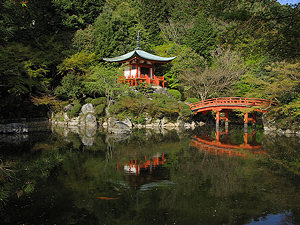 The path was steep, but it wasn't horrendous. For a start it was mostly
logs set into the earth rather than steep steps, and the rope in the
centre of the path seemed designed to separate people going up from
those coming down. It can be quite busy when the cherry blossom is
in bloom. Half way up there is a sacred waterfall and some benches. A
man gave me some candies as I sat admiring the view. The path through
the forest is a very pleasant one. It's wide and it isn't at all
gloomy. Near the top, a monk filled my bottle with water from the
temple spring. It had taken me about an hour at a fairly leisurely
pace. The walk through the forest had left me feeling uplifted and
I felt energized as I entered the Junteido. This is how a pilgrimage
should feel and though there was no image on display I did a
spontaneous metta meditation for all beings. For the first time I
really knew what the pilgrimage is about. It's a way to purify the
mind, to improve one's mental state, if only for a short time.
The path was steep, but it wasn't horrendous. For a start it was mostly
logs set into the earth rather than steep steps, and the rope in the
centre of the path seemed designed to separate people going up from
those coming down. It can be quite busy when the cherry blossom is
in bloom. Half way up there is a sacred waterfall and some benches. A
man gave me some candies as I sat admiring the view. The path through
the forest is a very pleasant one. It's wide and it isn't at all
gloomy. Near the top, a monk filled my bottle with water from the
temple spring. It had taken me about an hour at a fairly leisurely
pace. The walk through the forest had left me feeling uplifted and
I felt energized as I entered the Junteido. This is how a pilgrimage
should feel and though there was no image on display I did a
spontaneous metta meditation for all beings. For the first time I
really knew what the pilgrimage is about. It's a way to purify the
mind, to improve one's mental state, if only for a short time.
About 20 minutes' walk north of Daigoji is the charming
Zuishin-in, the temple where legendary
Heian-era poet Ono no Komachi spent the last years of her life. It's
worth a look, although access is a bit easier from Ono station, one
stop north of Daigo station.
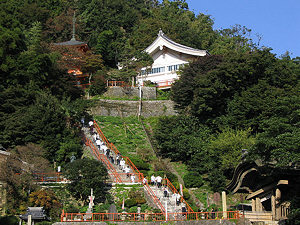 Hogonji (#30) November 2005.
I had been leaving the hard-to-reach temples till last, so November
2005 was when I got smart and asked the Tourist Information Office for
details on how to reach them. They can usually print out full details,
including bus schedules, if you tell them exactly when you want to go.
Hogonji is on Chikubushima Island in Lake Biwa, but it proved quite
easy to get to. I took the JR Kosei line to Omi-Imazu station, from
where it was a three-minute walk to the ferry. Ferries leave once an
hour and the deal is you buy a round-trip ticket, stay on the island
one hour and return on the boat you arrived on. The boat trip takes
about 30 minutes.
It was a sunny day and the lake was relatively calm, but in bad weather
the waves can be ferocious and the temple keeps a register of pilgrims
who died making the trip in former times. The island is just a
tree-covered rock with a small harbour on one side. From the harbour I
headed straight up some steps to the left and reached the large
Benten Hall and pagoda. From there I went back down more steps to the
unusual hondo with its thatched roof and carved doorway. From there an
open corridor leads to Tsukubusuma Shrine, and beneath the shrine is a
platform where you can throw clay disks into the sea, supposedly taking
your bad karma with them. The only other place I've seen clay disk
throwing is at Jingoji Temple west of
Kyoto.
Hogonji (#30) November 2005.
I had been leaving the hard-to-reach temples till last, so November
2005 was when I got smart and asked the Tourist Information Office for
details on how to reach them. They can usually print out full details,
including bus schedules, if you tell them exactly when you want to go.
Hogonji is on Chikubushima Island in Lake Biwa, but it proved quite
easy to get to. I took the JR Kosei line to Omi-Imazu station, from
where it was a three-minute walk to the ferry. Ferries leave once an
hour and the deal is you buy a round-trip ticket, stay on the island
one hour and return on the boat you arrived on. The boat trip takes
about 30 minutes.
It was a sunny day and the lake was relatively calm, but in bad weather
the waves can be ferocious and the temple keeps a register of pilgrims
who died making the trip in former times. The island is just a
tree-covered rock with a small harbour on one side. From the harbour I
headed straight up some steps to the left and reached the large
Benten Hall and pagoda. From there I went back down more steps to the
unusual hondo with its thatched roof and carved doorway. From there an
open corridor leads to Tsukubusuma Shrine, and beneath the shrine is a
platform where you can throw clay disks into the sea, supposedly taking
your bad karma with them. The only other place I've seen clay disk
throwing is at Jingoji Temple west of
Kyoto.
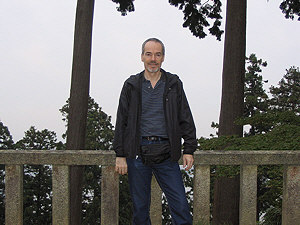 Chomeiji (#31) November 2005.
Chomeiji overlooks Lake Biwa from the eastern side. It's another temple
that requires a train and bus journey from Kyoto. The day was overcast
when I started up the 808 steep stone steps that lead through the
forest to the temple. With no sun and overhanging trees it was a gloomy
climb. As is often the case with mountain temples, pilgrims who have
their own transport can get closer to the temple and don't have to walk
as far. A group of pilgrims arrived at the same time as me, having
jumped out of a minibus not far from the top of the mountain. They lit
candles and chanted in front of the Kannon image in the hondo as I
admired the view and waited for them to leave. I love quiet
mountain temples and the Japanese do tend to be noisy in
groups.
Chomeiji (#31) November 2005.
Chomeiji overlooks Lake Biwa from the eastern side. It's another temple
that requires a train and bus journey from Kyoto. The day was overcast
when I started up the 808 steep stone steps that lead through the
forest to the temple. With no sun and overhanging trees it was a gloomy
climb. As is often the case with mountain temples, pilgrims who have
their own transport can get closer to the temple and don't have to walk
as far. A group of pilgrims arrived at the same time as me, having
jumped out of a minibus not far from the top of the mountain. They lit
candles and chanted in front of the Kannon image in the hondo as I
admired the view and waited for them to leave. I love quiet
mountain temples and the Japanese do tend to be noisy in
groups.
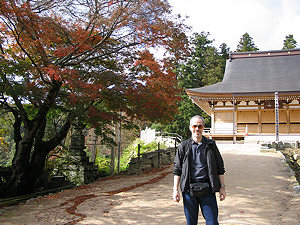 Kannonshoji (#32) November 2005.
Kannonshoji is also on the eastern side of Lake Biwa. After taking a
train on the JR Tokaido line to Notogawa, I exited the station and
jumped on a bus that left immediately for the temple. If you miss an
upcountry bus it will usually mean an hour's wait for the next one. I
informed the driver I was going to Kannonshoji so that he would make
sure I didn't miss the stop. And 45 minutes later he let me off at a
quiet village intersection and pointed to the right. I followed the
road for about 150 metres and came to a torii. There were signs
pointing left so I started down a road to the left, but a man standing
by the torii called out to me and pointed behind him. Inside the shrine
grounds was a narrow path leading up the mountain, and apparently that
was the way to the temple.
Kannonshoji (#32) November 2005.
Kannonshoji is also on the eastern side of Lake Biwa. After taking a
train on the JR Tokaido line to Notogawa, I exited the station and
jumped on a bus that left immediately for the temple. If you miss an
upcountry bus it will usually mean an hour's wait for the next one. I
informed the driver I was going to Kannonshoji so that he would make
sure I didn't miss the stop. And 45 minutes later he let me off at a
quiet village intersection and pointed to the right. I followed the
road for about 150 metres and came to a torii. There were signs
pointing left so I started down a road to the left, but a man standing
by the torii called out to me and pointed behind him. Inside the shrine
grounds was a narrow path leading up the mountain, and apparently that
was the way to the temple.
The walk to Kannonshoji is one of the highlights of the pilgrimage. It
isn't so steep you have to look down at the ground and it is lightly
wooded so it isn't gloomy. Although it takes an hour, it's a very
pleasant walk with an occasional view. Towards the top of the mountain
there are small stone figures of Kannon and Jizo beside the path, then
the dirt path turns into a gravel path and the temple entrance with its
black nio guardians appears. The temple burnt down in 1993 and
reconstruction of the hondo was only completed in 2004. The new
principal image, a seated Fukukensaku Kannon, is six metres high and
was carved from a 23-tonne block of sandalwood imported from
India.
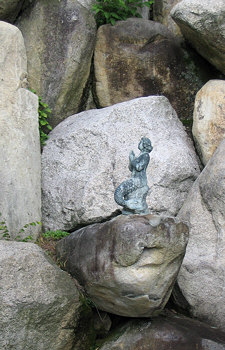 Although impressive, the huge image didn't resonate much with me.
Modern sculptors generally can't produce the beautiful facial features
that centuries-old images possess. And the power of an image as a lot
to do with knowing that hundreds of thousands of pilgrims have
worshipped before it over hundreds of years.
Although impressive, the huge image didn't resonate much with me.
Modern sculptors generally can't produce the beautiful facial features
that centuries-old images possess. And the power of an image as a lot
to do with knowing that hundreds of thousands of pilgrims have
worshipped before it over hundreds of years.
The legend of Kannonshoji is that a merman asked a young nobleman to
found a temple dedicated to Kannon so that he could pray for a better
rebirth. A scene from this legend is depicted on a wall made from large
boulders beside the hondo with Kannon standing at the edge of a "cliff"
and the merman praying far below. There is a fine view of the valley
below from the other side of the hondo and statues of Amida and the
nobleman of the legend are silhouetted against the sky.
When I reached the bus stop at the bottom of the mountain again, the
intersection was deserted. After 10 minutes the bus from Notogawa
arrived and a Japanese passenger got off. He stood in the middle of the
intersection looking down each road and scratching his head. He didn't
look like a pilgrim or day-tripper but he seemed to be in a hurry.
Eventually, he asked if I could speak Japanese. I said I didn't. Then
he said, "Kannonshoji?" I nodded and pointed towards the torii. He
bowed several times and hurried off. Not many Japanese go to remote
temples alone and without maps so assumed he had some urgent request to
make of Kannon.
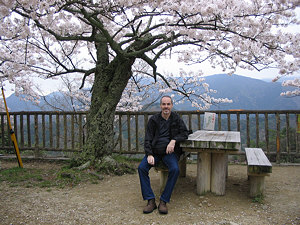 Makinoodera (#4) April 2006.
In 2006 I went Kyoto late in April in the hope of seeing some wisteria,
but unusually cold weather resulted in my arriving right in the middle
of cherry-blossom season. The blossom made the five pilgrimage temples
I visited so much brighter. The first on my list was Makinoodera, on
the way to Wakayama and not easy to reach. From Kyoto I took the JR
Sanyo line, the Osaka Loop line and then the Nankai line to Izumi-Otsu
station, where I took a Nankai bus to Makinoo-san. After an hour on the
bus I was left at a fork in the road. The bus took the right fork and
the driver had indicated I should take the left fork. There was a large
sign for Sefukuji Temple, which I didn't know at the time was the more
popular name for Makinoodera.
Makinoodera (#4) April 2006.
In 2006 I went Kyoto late in April in the hope of seeing some wisteria,
but unusually cold weather resulted in my arriving right in the middle
of cherry-blossom season. The blossom made the five pilgrimage temples
I visited so much brighter. The first on my list was Makinoodera, on
the way to Wakayama and not easy to reach. From Kyoto I took the JR
Sanyo line, the Osaka Loop line and then the Nankai line to Izumi-Otsu
station, where I took a Nankai bus to Makinoo-san. After an hour on the
bus I was left at a fork in the road. The bus took the right fork and
the driver had indicated I should take the left fork. There was a large
sign for Sefukuji Temple, which I didn't know at the time was the more
popular name for Makinoodera.
After a short while there was a T-junction and an arrow pointed right.
Pretty soon I was walking down a pleasant forest road beside a stream.
After 20 minutes I was getting a bit worried that I might be going in
the wrong direction so I asked a woman I met walking towards me. It
turned out she was collecting plants and a couple of minutes after we
parted she drove up in her car and gave me a lift to the base of the
mountain. The temple was a punishing half-hour climb up steep and
narrow steps, and the overhanging trees made it gloomy. But at the top
there were cherry trees in full blossom and a stunning view of the
surrounding mountains.
I had the place to myself for half an hour and then a pilgrim tour
group arrived led by a priest. They were very friendly, taking my photo
with the group and then waving goodbye as I headed back down the
mountain. An hour later their tour bus passed me as I was almost at the
bus stop. They all waved again. They probably thought I was lonely,
hiking in the mountains on my own.
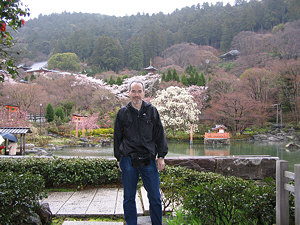 Katsuoji (#23) April 2006.
Katsuoji is another temple that is awkward to get to because of
infrequent buses. I took trains to Shin-Osaka, Esaka and Senri-Chuo,
and then switched to a Hankyu bus for the 45-minute ride through Osaka
suburbs to the temple gates. There was cherry blossom everywhere. A
path leads through the main gate, past a pond and up to a tahoto. To
the left of the tahoto is another path leading to the hondo and beside
the path is an enclosure full of red Daruma dolls. Daruma is the
Japanese word for Bodhidarma, the Indian monk who first brought Zen
Buddhism to China. The dolls have a spherical shape because it is said
that Bodhidarma meditated for so long that his arms and legs fell
off.
Katsuoji (#23) April 2006.
Katsuoji is another temple that is awkward to get to because of
infrequent buses. I took trains to Shin-Osaka, Esaka and Senri-Chuo,
and then switched to a Hankyu bus for the 45-minute ride through Osaka
suburbs to the temple gates. There was cherry blossom everywhere. A
path leads through the main gate, past a pond and up to a tahoto. To
the left of the tahoto is another path leading to the hondo and beside
the path is an enclosure full of red Daruma dolls. Daruma is the
Japanese word for Bodhidarma, the Indian monk who first brought Zen
Buddhism to China. The dolls have a spherical shape because it is said
that Bodhidarma meditated for so long that his arms and legs fell
off.
I never found the temple's famous 2.5-metre sandalwood carving of
Kannon, which I think was in a new hondo that is only open to the
public on the 18th of the month. There were paths leading up into the
forest but I didn't feel like exploring because of the heavy
rain.
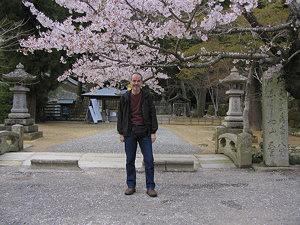 Ichijoji (#26) April 2006.
Ichijoji wasn't as hard as I expected - a JR Tokaido line train
straight through to Himeji station and then 35 minutes on a Shinki bus
to the temple gates. Again, lots of cherry blossom but unfortunately
the temple hondo was closed for renovation. Ichijoji's attractions
include a three-tiered pagoda dating from 1171 and a statue of Hodo
Sennin, one of the Chinese Immortals. Below the hondo is a quiet pond
and some old gravestones.
Ichijoji (#26) April 2006.
Ichijoji wasn't as hard as I expected - a JR Tokaido line train
straight through to Himeji station and then 35 minutes on a Shinki bus
to the temple gates. Again, lots of cherry blossom but unfortunately
the temple hondo was closed for renovation. Ichijoji's attractions
include a three-tiered pagoda dating from 1171 and a statue of Hodo
Sennin, one of the Chinese Immortals. Below the hondo is a quiet pond
and some old gravestones.
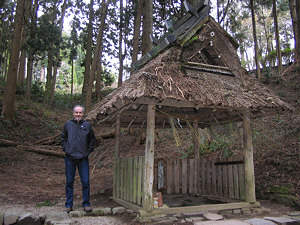 Kiyomizudera (Hyogo) (#25)
April 2006.
I had been dreading the trip to Kiyomizudera in Hyogo because it is
remote and there are very few buses. Taking the JR Tokaido line to
Amagasaki, I switched to the JR Fukuchiyama line and got off at Aino
station. Aino is a bleak town situated in a long valley. Bitter winds
and drizzle made for a freezing day and there was no shelter at the bus
stop. Eventually the No. 52 bus came and I got on with a Japanese
couple. We were the only passengers and I hoped they were going to the
temple. But they got off at the Hyogo Ceramics Museum, which was in the
middle of nowhere and looked utterly deserted.
Kiyomizudera (Hyogo) (#25)
April 2006.
I had been dreading the trip to Kiyomizudera in Hyogo because it is
remote and there are very few buses. Taking the JR Tokaido line to
Amagasaki, I switched to the JR Fukuchiyama line and got off at Aino
station. Aino is a bleak town situated in a long valley. Bitter winds
and drizzle made for a freezing day and there was no shelter at the bus
stop. Eventually the No. 52 bus came and I got on with a Japanese
couple. We were the only passengers and I hoped they were going to the
temple. But they got off at the Hyogo Ceramics Museum, which was in the
middle of nowhere and looked utterly deserted.
The bus took several turns on the half-hour journey so I knew I would
never be able to walk back if I missed the last bus from the temple. We
arrived at the base of the mountain, which looked like a small
terminus, and the bus driver announced it was Kiyomizudera. But as soon
as I got off the bus roared off up a road leading up the mountain!
There was a tollgate in the centre of the road so I tried to talk to
the two women manning the booth. They gave me an English leaflet about
the temple and pointed to a path leading into the trees. I was a bit
concerned because it was 1.15pm and I knew the last bus left the temple
at 2.15. I had expected to have an hour to look around and there I was
at the foot of the mountain.
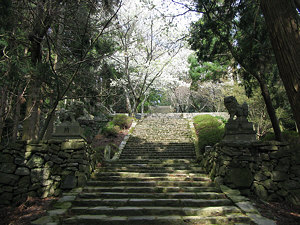 The rocky path turned out to be an old pilgrim's trail that went round
the back of the mountain, and as with the path to Kannonshoji, it
really provided a taste of the original Kannon pilgrimage. At the
back of the mountain the wind was really howling and the sky was
dark, but it didn't rain. Near the top I passed a stone statue of
Jizo and then came upon a long series of stone steps, with carved
lions at either side, that seemed to lead to nowhere. However, just
through the trees was an entrance to the temple grounds. The walk had
taken about 45 minutes.
The rocky path turned out to be an old pilgrim's trail that went round
the back of the mountain, and as with the path to Kannonshoji, it
really provided a taste of the original Kannon pilgrimage. At the
back of the mountain the wind was really howling and the sky was
dark, but it didn't rain. Near the top I passed a stone statue of
Jizo and then came upon a long series of stone steps, with carved
lions at either side, that seemed to lead to nowhere. However, just
through the trees was an entrance to the temple grounds. The walk had
taken about 45 minutes.
Without looking at the temple leaflet I headed over to the niomon (main
gate with two nio guardians) at the front of the mountain where I
thought the pilgrim's office and bus stop must be. In front of the
niomon was a huge, deserted parking lot but no pilgrim's office in
site. A woman saw me scratching my head and came out of her souvenir
shop. She indicated that the pilgrim's office was at the back of
the mountain and then took me to the bus stop where a bus was just
arriving. For a while it looked like I would have to leave on this last
bus without a stamp in my book, but the driver assured me there was
another bus at 4.30.
With over an hour to spare, I headed back to the Daikodo (lecture hall)
to see the Kannon image and have my book stamped. It was so cold the
monks were using electric heaters inside. I then took a look at the
priest's quarters and the moon-viewing pavilion. The ancient pagoda
had disappeared - only the stone foundations were visible - possibly
dismantled for renovation. After taking a short detour through the
forest I found the Okagenoido Well, but not much else, so I walked back
to the niomon expecting a 35-minute wait for the bus. The souvenir lady
seemed very surprised to see me and pointed back the way I'd come from.
OK, now I got it - the next bus would leave from the bottom of the
mountain, not the top. So back I went down the old pilgrim's trail
again, grateful in a way that circumstances had forced me to take this
picturesque path twice. My guidebook says this temple is "hard to
reach and even harder to leave - it doesn't invite lingering," and that
may be true but the path through the forest is really the main
attraction. I reached the bus stop with a few minutes to spare and was
on the bus just before it started to rain.
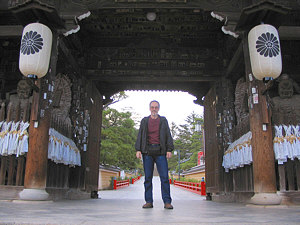 Nakayamadera (#24) April 2006.
Nakayamadera was a few stops down the line from Aino and since I had
read it was a busy neighbourhood temple I decided to chance it and hope
it was open later than the usual 5pm. Once out of Nakayamadera station,
I headed down an alley where a man on a bicycle pointed out the way to
the temple for me. The alley went round a pond, over the railway lines
and along to another station. The temple gate was just round the
corner. As I walked through the niomon at 5.40 a guard was looking at
his watch and all the buildings looked closed. But luckily the
pilgrim's office was open so I was able to have my book
stamped. It almost seemed like I'd had Kannon's help on this
particular day.
Nakayamadera (#24) April 2006.
Nakayamadera was a few stops down the line from Aino and since I had
read it was a busy neighbourhood temple I decided to chance it and hope
it was open later than the usual 5pm. Once out of Nakayamadera station,
I headed down an alley where a man on a bicycle pointed out the way to
the temple for me. The alley went round a pond, over the railway lines
and along to another station. The temple gate was just round the
corner. As I walked through the niomon at 5.40 a guard was looking at
his watch and all the buildings looked closed. But luckily the
pilgrim's office was open so I was able to have my book
stamped. It almost seemed like I'd had Kannon's help on this
particular day.
Like all Japanese temples that are known to assure women of an easy
childbirth, Nakayamadera has plenty of money. Most of the buildings are
new and there is even an escalator to take pregnant women up to the
hondo. It was raining, the halls were closed and there was nothing much
to see. In any case, the eleven-faced Kannon is apparently displayed
only on the 18th of each month. I noticed one building with a phoenix
at each end of the roof, in imitation of the Phoenix Hall at Byodo-in.
Nearby was a urinal with an open door at each end, allowing the wind to
blow cherry-blossom petals inside and scatter them all over the floor.
And with that unique image in my mind I set off back to Kyoto and a hot
bath.
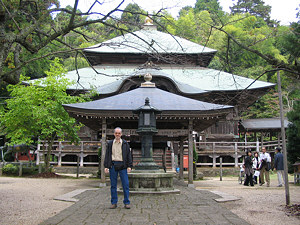 Matsunoodera (#29) November 2006.
I had decided to visit temples 28 and 29 on the same day as they are
both on Japan's west coast and not too far from each other. I
particularly wanted to get Matsunoodera out of the way first as it
sounded like it might be a hassle to get to. On the advice of Japanese
web sites I didn't intend to go all the way to the unmanned
Matsunoodera station and then walk to the temple because it would waste
a lot of time. Instead I took an express bound for Higashi Maizuru and
was told by the ticket inspector that the unreserved car I was sitting
in was going someplace else. I had to move to the first three cars
which all turned out to be reserved. It was only after some dodging
from seat to seat that I finally found one that didn't belong to
anyone.
Matsunoodera (#29) November 2006.
I had decided to visit temples 28 and 29 on the same day as they are
both on Japan's west coast and not too far from each other. I
particularly wanted to get Matsunoodera out of the way first as it
sounded like it might be a hassle to get to. On the advice of Japanese
web sites I didn't intend to go all the way to the unmanned
Matsunoodera station and then walk to the temple because it would waste
a lot of time. Instead I took an express bound for Higashi Maizuru and
was told by the ticket inspector that the unreserved car I was sitting
in was going someplace else. I had to move to the first three cars
which all turned out to be reserved. It was only after some dodging
from seat to seat that I finally found one that didn't belong to
anyone.
At Higashi Maizuru there were taxis at both exits and the drivers know
Matsunoodera temple. The trip takes 18 minutes, whereas walking from
Matsunoodera station takes 50 minutes along a very steep road through
the forest. The return trip cost me 6,300 yen, including 30 minutes
waiting. There are no taxis at the temple.
When I arrived at the hondo, an old man with a white beard was playing
a flute in front of the Bato (Horse-head) Kannon image. I rang the bell
outside, which prompted the man selling amulets to give me some
bell-ringing tips. Apparently, the technique is to hold the rope with
your right hand at eye level and your left hand as low as it can reach.
You then lift your left hand so that you are holding slack rope and
then pull back with the right arm and give the bell a good whack. This
produces a very loud and clear sound instead of the usual feeble
clanging.
There is a statue of a horse in front of the hondo, but otherwise not
much to look at. The nokyo is a red-roofed building outside the
temple gate. Back at the station I took a train one stop to Nishi
Maizuru and then transfered to the KTR line for the one-hour trip to
Amanohashidate.
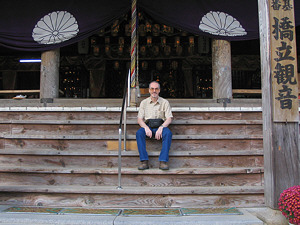 Nariaiji (#28) November 2006.
Amanohashidate is one of Japan's three most scenic spots and on a sunny
November weekend there are a lot of people there. I picked up a map at
the tourist booth in the station, turned right and second left, and
found myself entering the grounds of Chionji temple. From there I could
see the ferry pier and a bridge leading to the causeway across the
bay. Since I had plenty of time, I decided to walk. The land bridge
turned out to be 3.4km of pine trees and sand, with very nice views of
the sea on one side and the bay on the other. 40 minutes later I was at
the opposite pier, which was a few minutes' walk from the cable car and
ropeway. I took the ropeway, which was like a ski-lift in open chairs.
If you fall out of the chair, there's a 3-5 foot drop onto some wire
mesh below.
Nariaiji (#28) November 2006.
Amanohashidate is one of Japan's three most scenic spots and on a sunny
November weekend there are a lot of people there. I picked up a map at
the tourist booth in the station, turned right and second left, and
found myself entering the grounds of Chionji temple. From there I could
see the ferry pier and a bridge leading to the causeway across the
bay. Since I had plenty of time, I decided to walk. The land bridge
turned out to be 3.4km of pine trees and sand, with very nice views of
the sea on one side and the bay on the other. 40 minutes later I was at
the opposite pier, which was a few minutes' walk from the cable car and
ropeway. I took the ropeway, which was like a ski-lift in open chairs.
If you fall out of the chair, there's a 3-5 foot drop onto some wire
mesh below.
From the top of the ropeway there are great views of the bay and you're
supposed to look at it upside down between your legs so that it appears
Amanohashidate is suspended in mid-air. From there it's a shuttle bus
or steep walk to the temple gate. The temple features a "Bijin Kannon"
(Beautiful Kannon) and has benches outside the hondo to sit on. On the
return journey I found that the ropeway stops at 4pm so I had to take
the cable car. Since my guide map said Chionji had one of the three
best Monju sculptures in Japan, I took a speedboat across the bay into
the sunset and with the moon already rising to the east. But although
the temple was busy, there was no image on display. From Amanohashidate
there is a train direct to Kyoto.
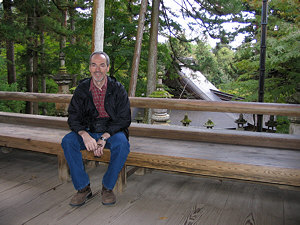 Kegonji (#33) November 2006.
The day I set off for the final temple it was cold with occasional
drizzle. The trip has to be planned carefully since it takes three
hours each way from Kyoto and involves three trains and a bus. The
first change is at Maibara and the second at Ogaki, where I bought a
ticket for the private Tarumi Tetsudo line at the JR window.
The train for Tanigumiguchi was a rinky-dink one-coach job that left
from an isolated platform. At some godforsaken place called Motosu
everyone got off and a few of us got on another train. At Tanigumiguchi
a bus was waiting and took off after a few minutes, covering the 3.5km
to the temple approach in eight minutes.
Kegonji (#33) November 2006.
The day I set off for the final temple it was cold with occasional
drizzle. The trip has to be planned carefully since it takes three
hours each way from Kyoto and involves three trains and a bus. The
first change is at Maibara and the second at Ogaki, where I bought a
ticket for the private Tarumi Tetsudo line at the JR window.
The train for Tanigumiguchi was a rinky-dink one-coach job that left
from an isolated platform. At some godforsaken place called Motosu
everyone got off and a few of us got on another train. At Tanigumiguchi
a bus was waiting and took off after a few minutes, covering the 3.5km
to the temple approach in eight minutes.
The bus stops at the bottom of a long, paved road lined with shops and
restaurants that leads up to the temple. It takes about 15 minutes to
walk to the gate. I stopped to eat some caramel ice cream and to look
at a shop full of carved buddha and bodhisattva images. Another shop
was selling pieces of quartz and animals carved out of tiger-eye stone
and serpentine. There were quite a few people at the temple, even
though most did not appear to be pilgrims. But a couple of pilgrims
were kneeling in front of the main image and had commissioned chanting.
I made my way to the nokyo inside the main hall to have the last entry
put in my pilgrim book. The monk who did it raised it to his forehead
as he gave it back to me. After that I spent an hour looking around and
then headed off back down the mountain. Thirty minutes later,
as the train moved out from Tanigumiguchi station, I noticed a
rainbow over the area I had just left.
Epilogue. It has taken me six years to complete the Saigoku
Pilgrimage. Along the way I met some very helpful people, saw some
temples a tourist wouldn't normally see, and got a sense of what a
pilgrimage really is. I have now moved on to other less well-known
Japanese pilgrimages. If I have any regrets, it's that I didn't learn
more about Buddhism - Japanese Buddhism in particular - and the various
types of Buddhist images before I started. If I had to pick some
highlights, I think the paths to Kannonshoji and Kiyomizudera at Hyogo
give a good idea of the original pilgrim experience, the Kannon statue
at Hasedera is the most impressive, and Ishiyamadera, Hogonji and
Engyoji are the most picturesque temples. Many of the temples are quite
easy to reach, even if you don't speak a word of Japanese, so there's
no reason even a tourist can't do part of the Saigoku circuit. And it's
always going to be a positive experience.


